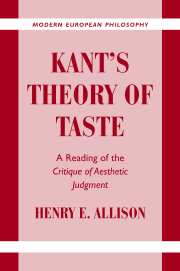Book contents
- Frontmatter
- Contents
- Acknowledgments
- Note on Sources and Key to Abbreviations and Translations
- Introduction
- PART I KANT'S CONCEPTION OF REFLECTIVE JUDGMENT
- PART II THE QUID FACTI AND THE QUID JURIS IN THE DOMAIN OF TASTE
- 3 The Analytic of the Beautiful and the Quid Facti: An Overview
- 4 The Disinterestedness of the Pure Judgment of Taste
- 5 Subjective Universality, the Universal Voice, and the Harmony of the Faculties
- 6 Beauty, Purposiveness, and Form
- 7 The Modality of Taste and the Sensus Communis
- 8 The Deduction of Pure Judgments of Taste
- PART III THE MORAL AND SYSTEMATIC SIGNIFICANCE OF TASTE
- PART IV PARERGA TO THE THEORY OF TASTE
- Notes
- Bibliography
- Index
6 - Beauty, Purposiveness, and Form
Published online by Cambridge University Press: 18 January 2010
- Frontmatter
- Contents
- Acknowledgments
- Note on Sources and Key to Abbreviations and Translations
- Introduction
- PART I KANT'S CONCEPTION OF REFLECTIVE JUDGMENT
- PART II THE QUID FACTI AND THE QUID JURIS IN THE DOMAIN OF TASTE
- 3 The Analytic of the Beautiful and the Quid Facti: An Overview
- 4 The Disinterestedness of the Pure Judgment of Taste
- 5 Subjective Universality, the Universal Voice, and the Harmony of the Faculties
- 6 Beauty, Purposiveness, and Form
- 7 The Modality of Taste and the Sensus Communis
- 8 The Deduction of Pure Judgments of Taste
- PART III THE MORAL AND SYSTEMATIC SIGNIFICANCE OF TASTE
- PART IV PARERGA TO THE THEORY OF TASTE
- Notes
- Bibliography
- Index
Summary
Following the “guiding thread” of the table of judgments in the Critique of Pure Reason, the third moment in the Analytic of the Beautiful is that of relation. Unlike the logical functions of relation or the relational categories, however, the relation in question is between the judging subject and the object judged and/or its representation. Thus, for the first time in the Analytic, the aesthetic object, which up to this point has been largely left out of the picture, becomes an explicit focus of attention.
Nevertheless, it is clear from both the inclusion of this discussion in the moment of relation and the emphasis placed on the representation of the object that the concern is not with the inherent nature of such an object, not even considered as phenomenon, but rather with the object qua represented, that is, apprehended in mere reflection, and its aesthetic, and therefore noncognitive and nonpractical, relation to the subject. Although it is never explicitly formulated as such, the basic question underlying the discussion is how we are to characterize this relation, such that it can account for the possibility of a universally communicable pleasure in the harmony of the faculties. Thus, as I shall try to show, the third moment presupposes and builds upon the results of the second in much the same way as the latter presupposes and builds upon the results of the first.
It is also in this context that Kant introduces the essential, yet deeply problematic, notions of a “purposiveness without purpose” and “form” (including both a “form of purposiveness” and a “purposiveness of form”) into the analysis of taste.
- Type
- Chapter
- Information
- Kant's Theory of TasteA Reading of the Critique of Aesthetic Judgment, pp. 119 - 143Publisher: Cambridge University PressPrint publication year: 2001



